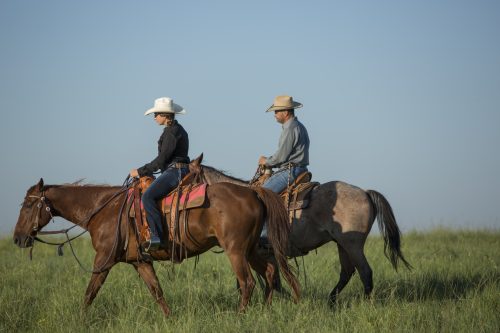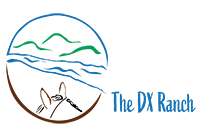When I think back to my earliest days horseback, the sensation of anxiety washes over me. As a child, it was pretty typical that this feeling would accompany old Tails and I on our ventures across Armstrong County. Whether we were moving pairs to the next pasture, checking on the calves, or helping the neighbor’s work their cattle, I worked hard to hide the nerves buried in my belly.
I was probably mounted on the most kid-broke gelding in the entire county. He’d seen a lot of country in his life, carrying my grandpa through numerous team-roping seasons and packing each of my older cousins around the ranch before me. Aside from being my first best friend, he was a veteran of all, and his expertise helped get us through any doubt of “oh-no-what-will-I-do-now” that popped into my mind. Man, oh man, how I’d love just one more ride on that gentle, friendly beast.
There are pictures of me horseback before I could walk on my own; by the age of six I had spent the better portion of my life sitting on a tipped over lick tub listening to dad as he worked with horses. Timing, patience, pressure, and release was the mantra of every lesson I sat through in that old, blue barn.
I was fortunate in my upbringing: my dad left the mug-em-tie-em-sack-em-ride-em way of horse-breaking behind before I came along, and ventured down his journey of becoming a better horseman after a good neighbor, and great friend of ours showed him that there was a better way around these beautiful animals.
You see, all that a horse desires is to be comfortable. If a horse is content, he needs not. And often, they learn to be less than content, and still need of nothing. They adapt to the environment around them, regardless of the situation. Horses have figured it out. Humans, well, we’re still getting there.
I don’t really recall my first ride without the feeling of a bottomless gut; in fact, it was just recently I realized I no longer carried this emotion into the saddle with me. Boy, I bet I’d feel a ton better to Tails now.
At some point in my growth of horsemanship, however, I realized that the fear I experienced was not caused by my lack of know-how, but my lack in control of the outside world’s chaos. Somewhere among a couple hundred miles horseback, from being ponied all the way up to putting the first ride on a two year old, the need to control chaos disappeared.

A more believable explanation is that I actually became aware such control was not possible. It was at that point in my horsemanship journey that I truly began to make progress. We are not able to manipulate every aspect in life, and horses can help us to learn that. All that we can do is prepare for the best, encourage great outcomes and adapt to the chaos when it arises.
I’ve come to learn that this is essential in not only horses, but in life. In fact, I’m not at all surprised that the loss of my useless anxiety passed by so unnoticed in my journey. I guarantee it was at that point in my life which my success with horses, work, and life in general, began to flourish.


Hi Kelsey,
I red your article in the Western Horseman and want to say that I am impressed with what you are doing and have accomplished. I too raise cow horses and have a small herd of cattle. I utilize the natural calm respectful training methods also. Light hands make light horses. It is fun and rewarding to see how fast a two year old will progress when you reward his efforts and let him learn what you are asking of him. They already know how to do the moves we just need to communicate to them so they know when we want those moves to be made. There is nothing better than a horse that understands what you ask and then response by giving 150% of there heart to you.
The reason I am writing is to introduce you to a cattle breed that we have experience awesome success with. My wife bought a few angus cows rather than invest in the stock market and we searched the internet and found the Red Wagyu or Akaushi breed. We purchased a bull and crossed them on the cows. To capitalize on the profit of our efforts we fed them until they were two years old and sold them through the local farmers market. Of course we ate some for ourselves also. We have been raised on cattle ranches and my first degree was in beef production management. The meat that we produced as a result of this cross is awesome to say the least. All of our steers have graded prime and the hamburger is to die for. The Japanese people developed the Wagyu and in fact Wagyu means Japanese cattle. The genetics developed by them in this breed instills the marbling inside of the muscle structure so the meat is more tender. The fat is of the omega 3, 6 and 9 varieties so it is like olive oil and very low in collateral.My daughter in law calls it marsh mellow beef. It is the only beef I will eat anymore.
On top of being great meat to eat the breed is also very producer friendly. They have low birth weights, very vigorous when they are born. They will get up and suck within the hour or two at the most. Most will suck the cow dry the first time and some will even bunt the cow demanding more to eat.The ones we have are very docile and we have made pets out of most of them. I only write to tell you because with the goal in mind to sell your beef locally the Akaushi cross will give you a very superior meat product to sell that all your neighbors will fall in love with. That was our thoughts why not have the best meat in the world to eat.Our website is Aspen Kreek Akaushi.com. If there is anything we can help you with let us know. I just wanted to share what we have found to work really well. Maybe you already know about them. They offer a lot of potential and would work great for what you are working to accomplish.
Best Regards, Garth Brinkerhoff